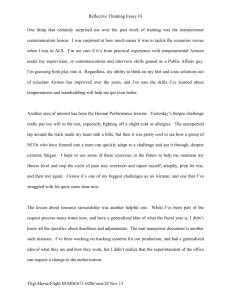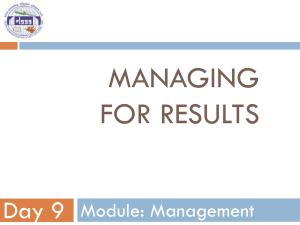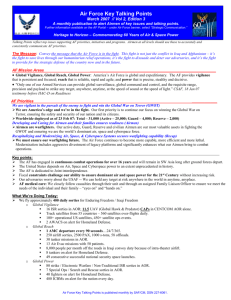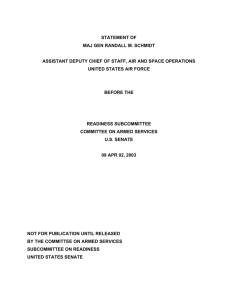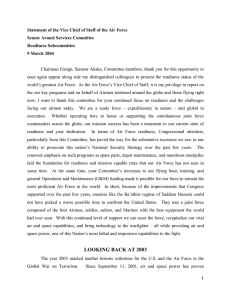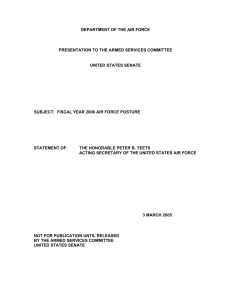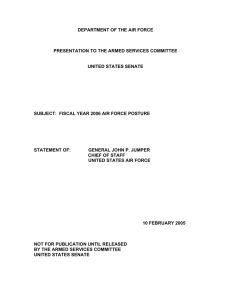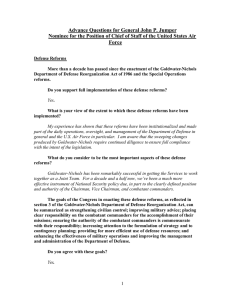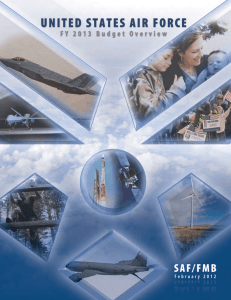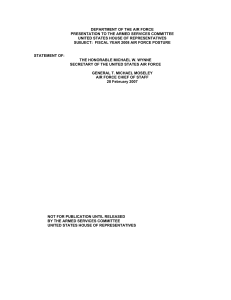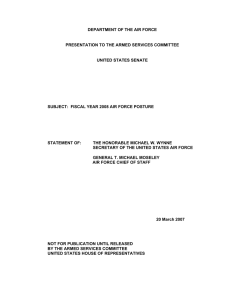Air Force Priorities for a New Strategy with Constrained Budgets
advertisement
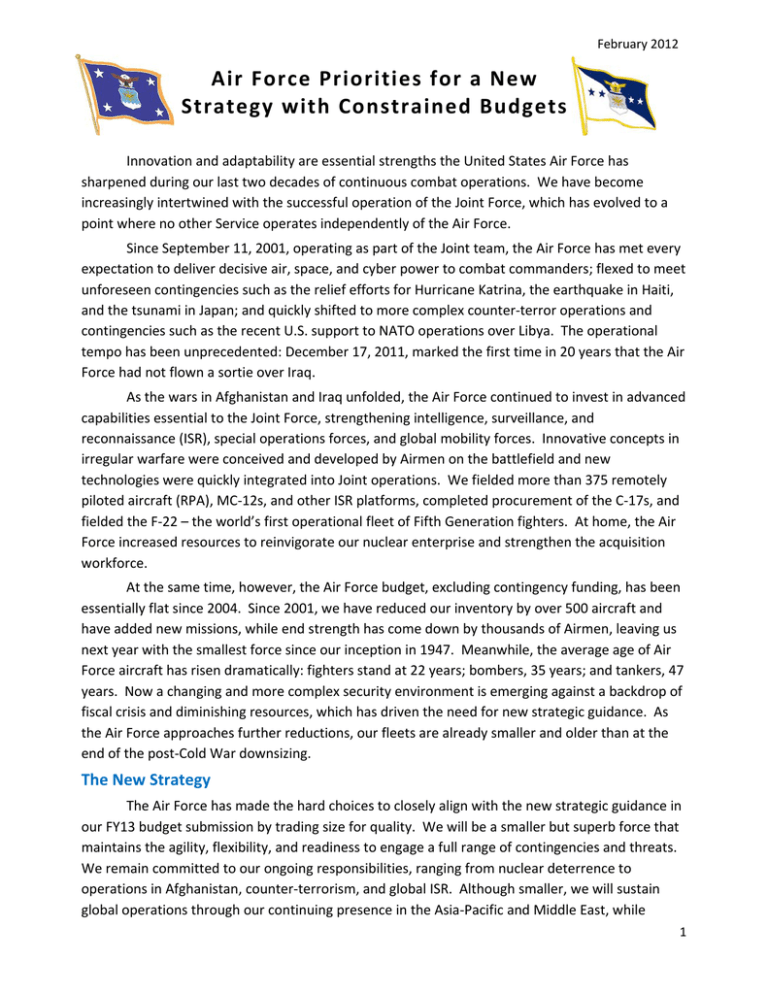
February 2012 Air Force Priorities for a New Strategy with Constrained Budgets Innovation and adaptability are essential strengths the United States Air Force has sharpened during our last two decades of continuous combat operations. We have become increasingly intertwined with the successful operation of the Joint Force, which has evolved to a point where no other Service operates independently of the Air Force. Since September 11, 2001, operating as part of the Joint team, the Air Force has met every expectation to deliver decisive air, space, and cyber power to combat commanders; flexed to meet unforeseen contingencies such as the relief efforts for Hurricane Katrina, the earthquake in Haiti, and the tsunami in Japan; and quickly shifted to more complex counter‐terror operations and contingencies such as the recent U.S. support to NATO operations over Libya. The operational tempo has been unprecedented: December 17, 2011, marked the first time in 20 years that the Air Force had not flown a sortie over Iraq. As the wars in Afghanistan and Iraq unfolded, the Air Force continued to invest in advanced capabilities essential to the Joint Force, strengthening intelligence, surveillance, and reconnaissance (ISR), special operations forces, and global mobility forces. Innovative concepts in irregular warfare were conceived and developed by Airmen on the battlefield and new technologies were quickly integrated into Joint operations. We fielded more than 375 remotely piloted aircraft (RPA), MC‐12s, and other ISR platforms, completed procurement of the C‐17s, and fielded the F‐22 – the world’s first operational fleet of Fifth Generation fighters. At home, the Air Force increased resources to reinvigorate our nuclear enterprise and strengthen the acquisition workforce. At the same time, however, the Air Force budget, excluding contingency funding, has been essentially flat since 2004. Since 2001, we have reduced our inventory by over 500 aircraft and have added new missions, while end strength has come down by thousands of Airmen, leaving us next year with the smallest force since our inception in 1947. Meanwhile, the average age of Air Force aircraft has risen dramatically: fighters stand at 22 years; bombers, 35 years; and tankers, 47 years. Now a changing and more complex security environment is emerging against a backdrop of fiscal crisis and diminishing resources, which has driven the need for new strategic guidance. As the Air Force approaches further reductions, our fleets are already smaller and older than at the end of the post‐Cold War downsizing. The New Strategy The Air Force has made the hard choices to closely align with the new strategic guidance in our FY13 budget submission by trading size for quality. We will be a smaller but superb force that maintains the agility, flexibility, and readiness to engage a full range of contingencies and threats. We remain committed to our ongoing responsibilities, ranging from nuclear deterrence to operations in Afghanistan, counter‐terrorism, and global ISR. Although smaller, we will sustain global operations through our continuing presence in the Asia‐Pacific and Middle East, while 1 tailoring our presence in Europe. Air Force capabilities are fundamental to the major priorities of the new strategic guidance, such as deterring and defeating aggression, power projection in anti‐ access and area denial (A2/AD) environments, preventing the spread of weapons of mass destruction, space and cyber operations, and strategic deterrence. Though virtually every area of the Air Force budget faces constrained resources, we have taken care to protect the distinctive capabilities on which our Joint, Interagency, and Coalition teammates depend. The enduring capabilities that Airmen provide every day are: Air and Space Control; Global Intelligence, Surveillance and Reconnaissance; Rapid Global Mobility; and Global Strike. The Service has also maintained the cross‐domain command and control necessary to make these capabilities effective across the full spectrum of conflict. In order to protect these Joint contributions, we have minimized reductions, or in some cases increased our investments, in areas such as Long Range Strike, Air‐Sea Battle related programs, RPAs, aerial refueling, global mobility, and special operations. The difficult decisions that are required to achieve the Air Force’s initial share of the $487 billion of defense savings mandated by the Budget Control Act (BCA) fall into five broad subject areas: Force Structure, Readiness, Modernization, More Disciplined Use of Defense Dollars, and Taking Care of Our People. It took innovative and adaptive thinking to rebalance Air Force resources over the next several years in ways that will enable our essential contributions to the new strategy. Confronted by a more complex and dynamic security environment, as well as a significant reduction in defense resources, the Air Force determined that the best path forward is to become smaller in order to protect a high quality force that will improve in capability over time. To avoid a hollow force, we will protect readiness at any force level and strengthen our integration of the Total Force team of Active, Guard, and Reserve Airmen. We are slowing modernization, terminating or deferring numerous acquisition programs, but at the same time protecting the key programs most critical to future Air Force capabilities. Force Structure The Air Force provides strategic agility, buying down risk for the Joint Force during changing threat and resource environments. Preservation of a highly responsive and scalable force was paramount as we considered the force structure elements of the FY13 budget submission. Nonetheless, significant reductions to force structure and manpower are necessary to ensure we have the resources to support a ready force today and a modern force capable of meeting future challenges. The Air Force carefully balanced the contribution of the Active and Reserve Components to preserve both readiness and capability. 2 More than 280 aircraft have been identified in the current budget submission for elimination across all Air Force components over the next five years. This includes 123 fighters (102 A‐10s and 21 older F‐16s), 133 mobility aircraft (27 C‐5As, 65 C‐130s, 20 KC‐135s, and 21 C‐ 27s), and 30 select ISR systems (18 RQ‐4 Block 30s, 11 RC‐26s, and one E‐8 damaged beyond repair). In planning for a smaller force, our decisions favored retention of multi‐role platforms over those with more narrowly focused capabilities. Where feasible, we sought to divest smaller fleets with niche capabilities and will also focus on common configurations for key platforms in order to maximize operational flexibility and minimize sustainment costs. Multiple units and every state and territory will be affected by aircraft or manpower reductions. For Air National Guard units, mitigations are planned, such as backfilling affected units with RPA or ISR missions. Although some squadrons will actually grow larger, it is unlikely that there will be a 100 percent backfill of personnel or alternative mission for every location. These force structure changes result in further personnel reductions of 9,900 Active, Guard, and Reserve Airmen on top of the reduction of 48,000 personnel since 2004. Specific reductions were driven by continuing operational demands placed on the Air Force in the new strategy. Yet, more than ever, the Air Force remains committed to utilizing our Reserve Components as an operational force. While reducing the size of the Air Force, we will strengthen the integration of the Total Force by increasing Active‐Reserve Component Associations from 100 to 115 to grow the experience of Active Airmen and augment Reserve Component capacity. Readiness As demonstrated in operations over Libya last year, requirements for Air Force capabilities can emerge with very little notice. The current security environment continues to require a highly agile and responsive force; so, as the Air Force gets smaller, maintaining preparedness is even more important to executing the strategic guidance. As with our sister Services, a heavy operations tempo since 9/11 has resulted in some detrimental effects on our overall readiness, particularly in the context of aging weapons systems, lost opportunities for full‐spectrum training, and stress on our personnel. Assuming manageable risks, we funded our Weapons System Sustainment at 79 percent of requirements in the FY13 budget request, and our facility sustainment was funded at just over 80 percent of the facility sustainment model. The emphasis on readiness in the new strategic guidance has reinforced the importance of maintaining our Flying Hour Program through a combination of the baseline budget, the Overseas Contingency Operations budget, and an increasing utilization of Live, Virtual, and Constructive Operational Training capabilities. We will continue to revise our readiness tracking systems to provide more informed and refined assessments, and Air Force leaders are closely watching readiness trends to ensure we remain responsive and effective, avoiding a “hollow” force. Modernization Perhaps the most significant challenge facing the Air Force is our need to continue modernizing the force even as budgets are in decline. To meet this challenge in the current fiscal environment, we are slowing the pace and scope of modernization while protecting programs 3 critical to future warfighter needs. Focused investment in high priority programs such as the F‐35 Joint Strike Fighter, Long Range Strike Bomber, KC‐46 refueling tanker, service‐life extension of the F‐16, Space‐Based Infrared and Advanced EHF satellites, and our space launch capability is critical to the Department’s overall strategy. Access and continued freedom of maneuver within cyberspace is an essential requirement for our networked force, therefore the development of offensive and defensive cyber capabilities remains a top Air Force priority. Additionally, in coordination with the Navy, the Air Force will fund modern radars, precision munitions, and other priorities to support the Air‐Sea Battle concept and ensure worldwide power projection despite increasing A2/AD challenges. To continue funding these high priority investments, we made the hard choices to terminate or restructure programs with unaffordable cost growth or technical challenges such as the RQ‐4 Block 30, B‐2 Extremely High Frequency radio improvements, and the Family of Advanced Beyond Line of Sight Terminals. We eliminated expensive programs with more affordable alternatives that still accomplish the mission, such as the C‐130 Avionics Modernization Program, the C‐27J program, and Defense Weather Satellite System. Likewise, we discontinued or deferred programs that are simply beyond our reach in the current fiscal environment, such as the Common Vertical Lift Support Platform, Light Mobility Aircraft, and Light Attack and Armed Reconnaissance aircraft. The FY13 budget also accepts significant near‐term risk in military construction for current mission facilities, limiting ourselves to projects required to support new aircraft bed downs and emerging missions. Underpinning the Air Force’s ability to leverage and field these crucial technologies is America’s aerospace research and development infrastructure—a national asset that must be protected to ensure future U.S. advantages in technology and civil aerospace. Therefore, the Air Force’s budget protects science and technology funding as a share of our total resources. More Disciplined Use of Defense Dollars Since June 2010, when the Secretary of Defense challenged the Services to identify efficiencies in overhead, support, and other less mission‐essential areas, the Air Force moved aggressively to enforce a more disciplined use of defense dollars. Building on the originally identified $33.3 billion in efficiencies, our FY13 submission proposes an additional $3.4 billion in new efficiencies across the Future Years Defense Program by reexamining cost areas such as information technology, service contracts, travel, and inventory controls. Encouraging signs since FY10 in areas like government travel ($219 million reduction through FY12) indicate that our drive to continuously improve Air Force business practices is showing progress. Identifying opportunities to streamline headquarters, consolidate field‐level activities, find cheaper, more efficient energy, and performing regular field‐level inventory reviews are now institutionalized elements of normal Air Force business. Nonetheless, we recognize that our future operation and maintenance funding depends on our ability to achieve these efficiencies. 4 Taking Care of Our People Innovation and adaptability are not derived from aerospace technology or world class infrastructure; rather, it is our Total Force Airmen themselves who enable America’s leadership in air, space, and cyber. However, personnel costs continue to be vexing—military personnel costs have doubled DoD‐wide since FY01 while the number of full‐time military personnel, including activated reserves, has increased only eight percent. Any solutions to this problem will be deliberate, will recognize that the All Volunteer Force is the core of our military, and will not break faith with the Airmen and families who serve our Nation. The Air Force is approaching its investment strategy in a way that seeks to retain the highly motivated and battle‐tested workforce necessary to execute the Air Force mission. To this end, we emphasized funding for wounded warriors, lodging, mental health, modernized food services, and fitness centers. We have also strengthened our Airman development programs by enhancing technical training, professional military education, and language and culture programs. To support our families, we protected several essential family support programs, such as child care and youth programs, school liaison officers, and the completion of our on‐base privatized housing program at stateside installations. Conclusion Defense cuts totaling $487 billion over 10 years will be hard but manageable, though significant challenges remain. The need to transition contingency appropriations into baseline budgets still overhangs DoD resource planning, excess basing capacity still needs to be addressed through the proposed Base Realignment and Closure Commission, and many more decisions due to unforeseen events will intervene in the next decade. The Air Force’s FY13 budget request is the culmination of an unprecedented season of difficult choices. We can and expect to absorb currently programmed reductions with increased but acceptable risk, provided no further cuts are enacted. The possibility of the BCA reducing defense spending by billions more will put at risk our ability to execute the new strategic guidance. Given the continuing complexity and uncertainty in the strategic environment, and facing substantial budget reductions, DoD and Air Force resources are appropriately targeted to promote agile, flexible, and cost effective forces that mitigate strategic risks. Modernization of air, space, and cyber systems is required to maintain our advantages in these contested domains, and to ensure the success of Joint and Coalition forces in any operation across the spectrum of conflict. Despite the many challenges we have faced, today’s Air Force is, by any objective standard, the world’s best. It is our intent, indeed our obligation, to the American people and our Airmen to remain the world’s finest Air Force in the years and decades to come. Innovative and adaptable, America’s Air Force will continue to meet emerging challenges and ensure the security of the Nation and its bright future. 5
